Last year, Sky Light Research wrote a paper on microwave being able to meet the requirements of 5G. That paper explored various benchmarks that microwave needs to meet for 5G to be successful – capacity, low latency, high cell densification, and flexible OAM through software. As 5G progresses, detailed requirements for each of these is becoming clearer. The need for more capacity continues to be a constant theme and is particularly challenging because, although networks need more capacity, operators typically don’t have a lot of extra spectrum. Thus, existing spectrum needs to be used as efficiently as possible. Capacity limits are being tested by: (1) subscribers using more data than they had in the past; (2) an increase in the number of subscribers, and; (3) a growing number of devices connected to the internet. All of this creates stress on the network, forcing operators to make changes in the network. As the network is pressed to reach higher data capacity limits, microwave radio manufactures have developed ways to meet these increasing capacity needs, while using spectrum efficiently. The following are a few of the most promising advancements:
XPIC
XPIC (Cross-Polar Interference Cancellers), uses both the horizontal and vertical polarized waves within two channels on a single frequency link with cross polar cancellation algorithms at the receiver. XPIC technology doubles the capacity of the microwave or E Band link while ensuring efficient use of the spectrum. XPIC is available from almost every major microwave manufacturer and has been used in mobile backhaul networks for years. The benefits from XPIC are multiplied when used in conjunction with dual band solutions, which combines two different frequencies onto one link.
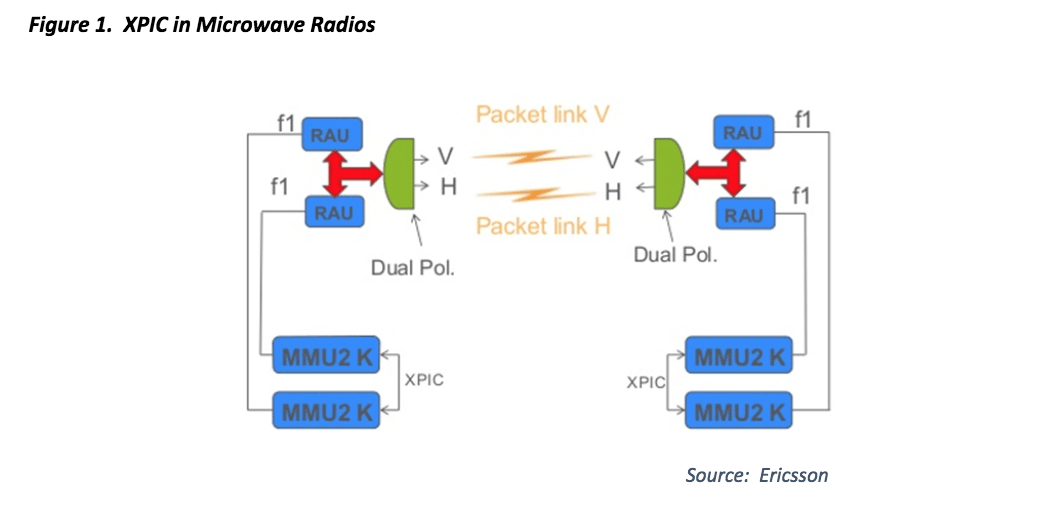
MIMO
MIMO (Multiple Input Multiple Output) is another technique used to increase capacity. MIMO aggregates multiple antennas at the transmitter and receiver sites. Each antenna adds another carrier onto the frequency channel and each carrier adds more capacity. MIMO effectively doubles the capacity in a single channel through spatial separation by transmitting two signals over separate antennas. The smaller the separation distance, the more efficiently spectrum is used. Huawei has reported that they have developed algorithms that reduce the separation space to just one third of what it used to be, which frees up overhead space for more capacity throughput. Thus, MIMO not only increases capacity substantially, but also uses spectrum more efficiently. This is key, especially in regions where spectrum is scarce and/or very expensive.
Additionally, due to the larger number of antennas per head end, antennas often use a narrower beam (i.e. beam forming) to prevent interference with other antennas. This is especially true with massive MIMO, which is the same concept as MIMO but with a larger number of antennas per head end – basically the more antenna ports, the more data throughput. Massive MIMO will be a fundamental technology for 5G and a several operators throughout the world already are testing the technology. In Indonesia, mobile operator Telkomsel, increased capacity 5x on the network just by moving from 2 x 2 MIMO to massive MIMO. Although this was on the RAN network, the same principal applies to backhaul.
Despite all the benefits MIMO heralds, it does need to be deployed strategically to minimize costs and maximize gains. Because of the tower space requirements and the proximity of antennas, MIMO can be challenging to deploy, but microwave manufacturers are overcoming this with various solutions, such as dual carrier antennas, small cells, and smaller antennas, just to name a few. Tower space is scarce and expensive. Thus, the less tower space that is used, the more profitable the business case.
Carrier aggregation
Carrier aggregation is exactly what its name implies – it combines multiple channels or carriers in a single frequency to achieve a higher throughput of data in one virtual link. When combining data over multiple carriers, a strong radio link bonding technology is critical to keep overhead minimized and the link as spectrally efficient as possible. With carrier aggregation, the number of ODU’s are minimized, because the technology aggregates channels on a system level, requiring only one ODU, as opposed to several ODUs daisy chained together to achieve higher capacity throughput. This is key to keeping operational costs manageable, because, to reiterate, renting tower space is expensive, and can quickly blow up the business case, if left unchecked. It’s also noteworthy to mention that, traditionally, links were set up with a protected link in hot standby mode, but now it’s more likely that links are set up with the backup link bonded with the primary link to increase capacity. When multiple channels are bonded, capacity increases correspondingly – thus the capacity throughput is the sum of each channel’s capacity.
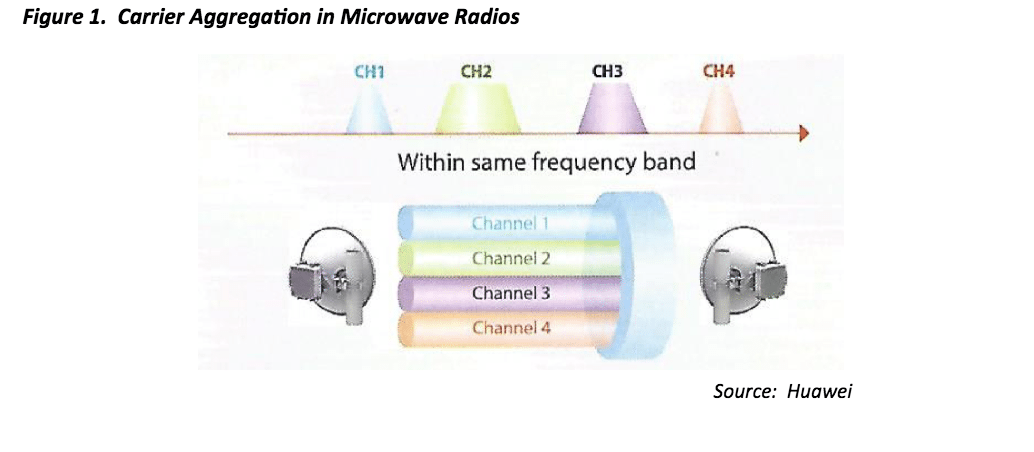
To further increase capacity, higher order modulation schemes can be added as well as larger channel sizes. Capacity further increases as modulation schemes rise, so a 2+0 bonded link in a 500 megahertz channel will have higher capacity at 1024 QAM vs 256 QAM. In February 2018, Vodafone and Huawei announced that lab trials, performed in Italy, achieved up-to-2.7 Gbps capacity throughput with 0.05 milliseconds latency. The trial aggregated two 112 megahertz channels into one microwave link. Low latency was achieved through enhancements to the modem and RF unit.
Dual bands
Not only does capacity increase substantially when channels within traditional microwave bands (6 -42 GHz) are aggregated, but when a traditional microwave band and a millimeter wave 80 GHz band are combined, capacity can reach10 Gbps, covering a span of up to 7km. By combining two frequencies, the link can leverage the best characteristics from each band, thus, reliability and distance can be exploited from the microwave band, while capacity and or latency can be exploited from the millimeter wave band. Millimeter wave frequencies have much wider channels than traditional microwave frequencies and therefore supports higher capacities. Research is ongoing to move beyond the 80 GHz band to the W band (75 -110 GHz) or D band (130-170 GHz) which will push capacity beyond 10 Gbps. The chart below illustrates the concept of combining E band frequencies with traditional microwave frequencies.
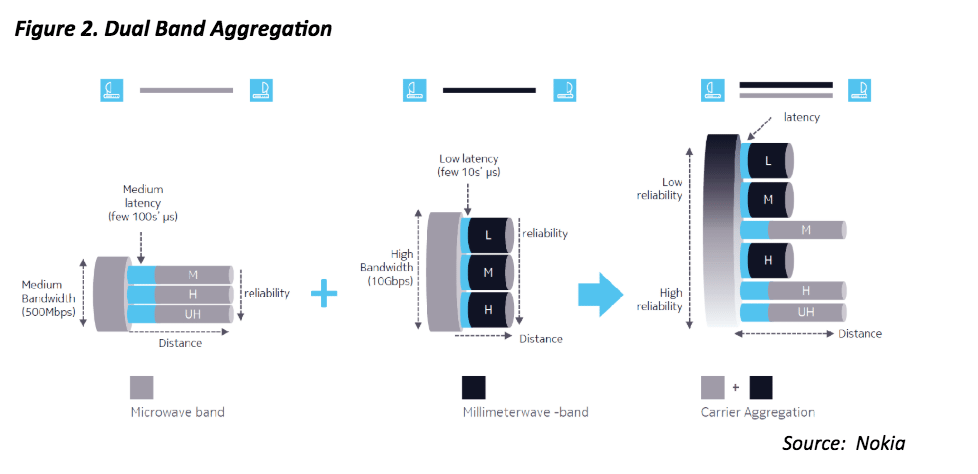
Intelligent load balancing technology in dual band solutions is critical, because if load balancing is not done correctly, it can have far reaching cost implications on the rest of the network. Load balancing technology not only creates more bandwidth efficient links, but it can also impact how many antennas are required and how well dual band radios work when combined with other technologies like XPIC or MIMO. Numerous antennas can quickly disrupt the profit model due to unnecessary equipment costs and tower rental space. New multiband antennas will help to mitigate some of the this as well.
Leading microwave vendors have announced dual band (MMW/MW) radios that are starting to ship. This is significant, because the first phase of 5G is expected to start rolling out in select areas in 2018-2019 timeframe. Initially most deployments will be fixed, but mobile 5G should start around 2020-2021, which means backhaul will start in 2019 – 2020. It is expected that South Korea, North America, and China will be the first regions to roll out 5G. Operators like AT&T and Verizon have already done regional testing in the USA. In all three regions, the fiber infrastructure is ubiquitous, and initially, microwave backhaul will take a smaller role. As cell density increases, microwave and/or millimeterwave backhaul will become more common and the use of dual bands will increase.
In regions like India, spectrum efficiency will be critical due to the large amount of subscriptions that are expected. India’s large population and limited telecommunications infrastructure makes it an ideal market for microwave backhaul. However, to take part in the Indian digital evolution, spectrally efficient radios will be key. If history repeats itself, it is likely only a small number of microwave manufacturers will benefit from India, due to its onerous selection process.
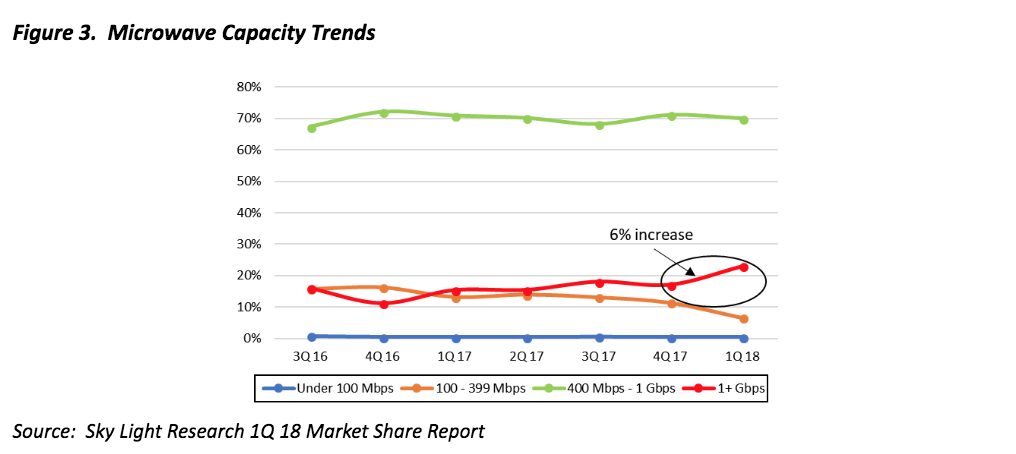
Adaptive modulation and high modulation
As mentioned earlier, modulation schemes are a robust way to increase capacity while using spectrum efficiently. Modulation can be combined with other capacity increasing techniques which makes adaptive modulation a popular choice among operators. Adaptive modulation dynamically alters the throughput according to the quality of the signal. So, in times of bad weather, the link will degrade in order to not lose any packets. Conversely, with good weather, and an optimal signal, the throughput will increase to higher levels.
The following diagram shows the incremental capacity level that can be gained by using higher order modulation in a microwave radio on the market today. Although, 8192 QAM is available today, it is not shown here, as this is meant to provide a snapshot of capacity gains with higher order modulation. Keep in mind that even though adaptive modulation is a spectrally efficient method by which to increase capacity, there does come a point of diminishing returns versus expense.
Looking at the chart below, the trend towards higher capacities is apparent. Capacity in the 400 Mbps -1 Gbps range are the bulk of microwave radio revenue, but in 1Q 18, SLR saw a shift to 1+ Gbps radios starting to take place. This trend will accelerate over the next five years.
![]()
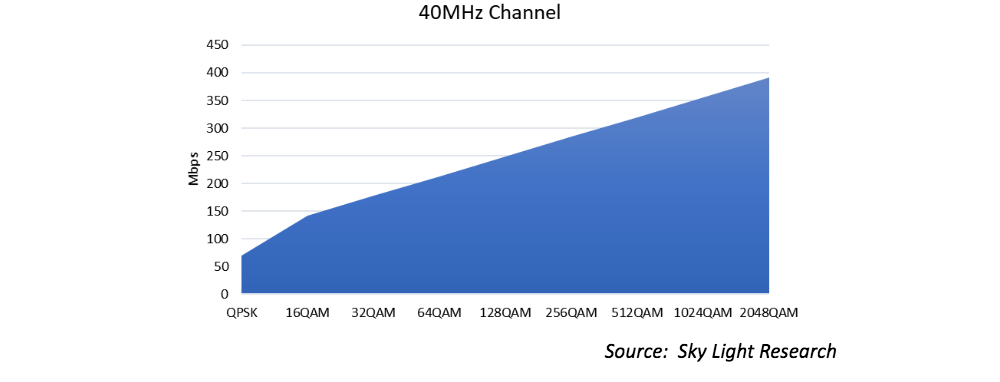
The importance of antennas
High quality antennas optimize the technology advances in microwave radios. Pairing a low grade antenna with a high end microwave radio defeats the purpose of investing in a more expensive radio. Since the antenna is the means through which all traffic flows, skimping on the technology at this point, prohibits the rest of the system to operate as efficiently as it was designed. Although lower end antennas cost less upfront, they can create an overflow of signals, cause interlink interference, and lower the signal to noise ratio performance. The end result? Lower capacity, potential congestion, sub-par performance, and higher TCO. With limited spectrum resources, and more capacity and functionality demands, quality antennas help keep TCO in check.
Wider channels, more channels, and/or frequency reuse are all important elements in many of the capacity increasing techniques discussed above. It’s essential to deploy these techniques correctly so spectrum is used as efficiently as possible. High quality antennas typically have methods that control the signal better through beamforming and/or low side lobe levels. Low side lobe antennas allow more higher capacity radio links to be packed into a given geographic area, especially when frequency re-use is necessary. Commscope is one antenna manufacturer that has taken this to heart. Although, Commscope has a wide range of antennas, its UHX and Class 4 Sentinel antennas were built with these challenges in mind.
Additionally, advanced antennas also provide a relatively fluid upgrade to carrier aggregation with just one antenna. RFS announced at MWC 2018, a new dual band antenna. By using a single dual band antenna for carrier aggregation, it has been shown that TCO and CAPEX/OPEX are reduced by minimizing transportation needs, installation time, and tower loading and rental fees – all of which can add up quickly. Nokia’s Wavence radios use an antenna similar to this. Nokia’s antenna, via a partnership with MTI Wireless Edge, reduces space on the tower by aggregating two frequencies into one antenna. The antenna integrates 18 GHz and 80 GHz frequencies into a dual band two-foot parabolic antenna, again saving the operator money in TCO and CAPEX/OPEX.
Another concern of operators is seamless upgrades as they move from 4G to pre 5G networks. Antennas play a major role in cost savings, depending on the sophistication level of the antenna. Expense is not only in the equipment, but also in the labor and delivery time. To help alleviate this, microwave manufacturers have developed modular antennas, which, with relatively small hardware changes, can switch frequencies and/or add capacity. The figure below illustrates an antenna that Huawei offers. Huawei reports a 40 percent savings in delivery time and 60 percent savings in installation and commissioning costs with the new antenna.
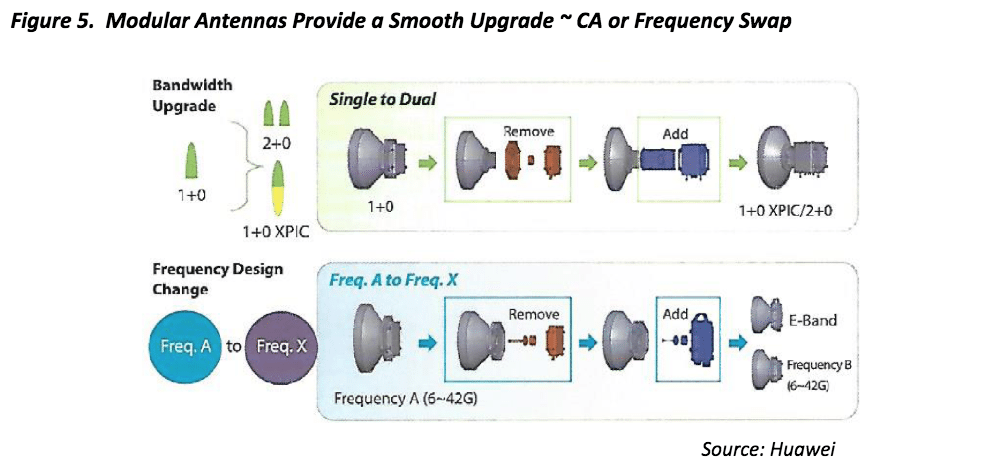
Low link latency
Low link latency is a critical component to 5G, and unlike many other 5G features, cannot be achieved on 4G networks. The chart below illustrates current and future 5G latency requirements, and as you can see, depending on the application, latency requirements vary:
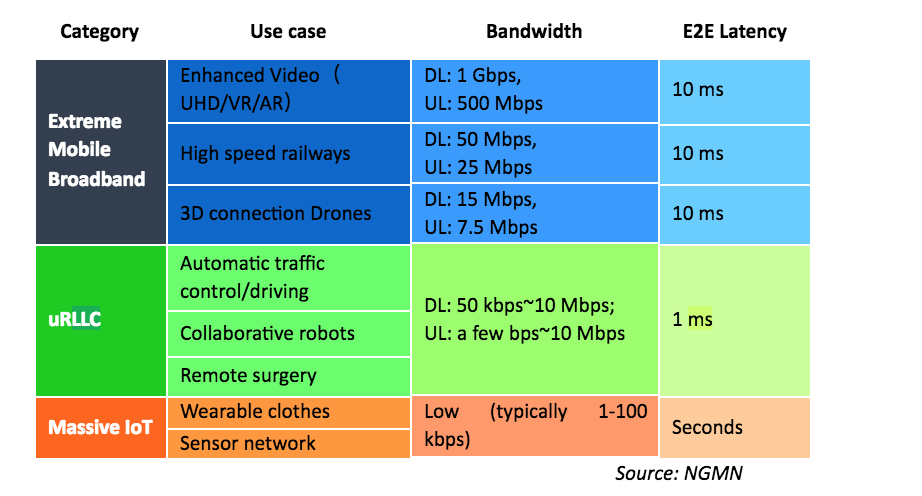
The green band is the most latency sensitive, requiring an end to end latency of no more than 1ms. These applications generally involve life and death situations. Mobile broadband requires no more than 10 milliseconds for end to end latency, which means backhaul latency cannot exceed 5 milliseconds. These low latency levels are attainable by leveraging manufacturers’ algorithms in various deployment modes like small cells and wider channels. Smaller cells shorten the transport path and thus lowers latency, while wider channels inherently improve latency – both techniques are ideal for millimeterwave bands above 70 GHz or for the dual band MW/MMW solution. Because each microwave manufacturer has its own way of achieving lower latency, it’s important to research which way works best with your network design.
Summary
As 5G makes its way into trials and small local deployments, what works and doesn’t work is becoming clearer. Every microwave manufacturer has a 5G roadmap, each with a slightly different twist on how it solves the issues at hand. It is clear, however, that millimeter wave bands above 60 GHz will play a key role in backhauling small cells and 5G networks. These newer bands, combined with traditional bands, along with carrier aggregation techniques, antenna advancements, and capacity boosting technology such as XPIC, MIMO, and higher order modulation algorithms, promise an exciting future for microwave.
The post Analyst Angle: Microwave sharpens its edge for 5G backhaul appeared first on RCR Wireless News.
